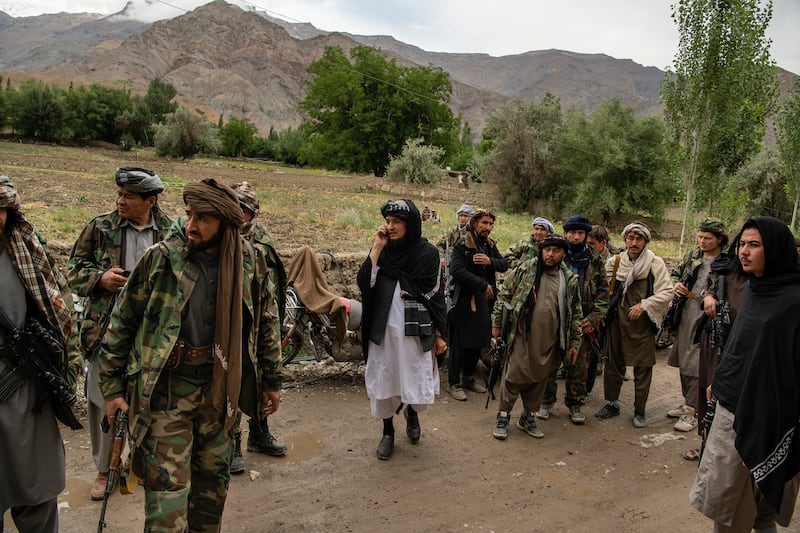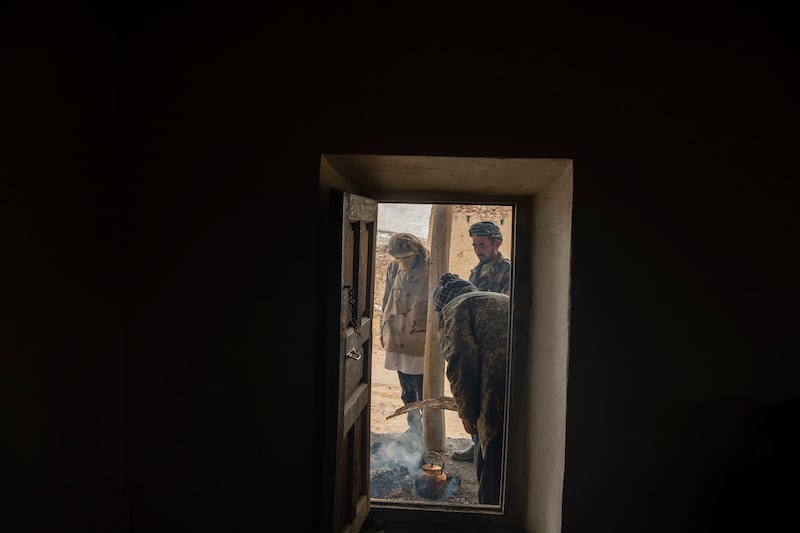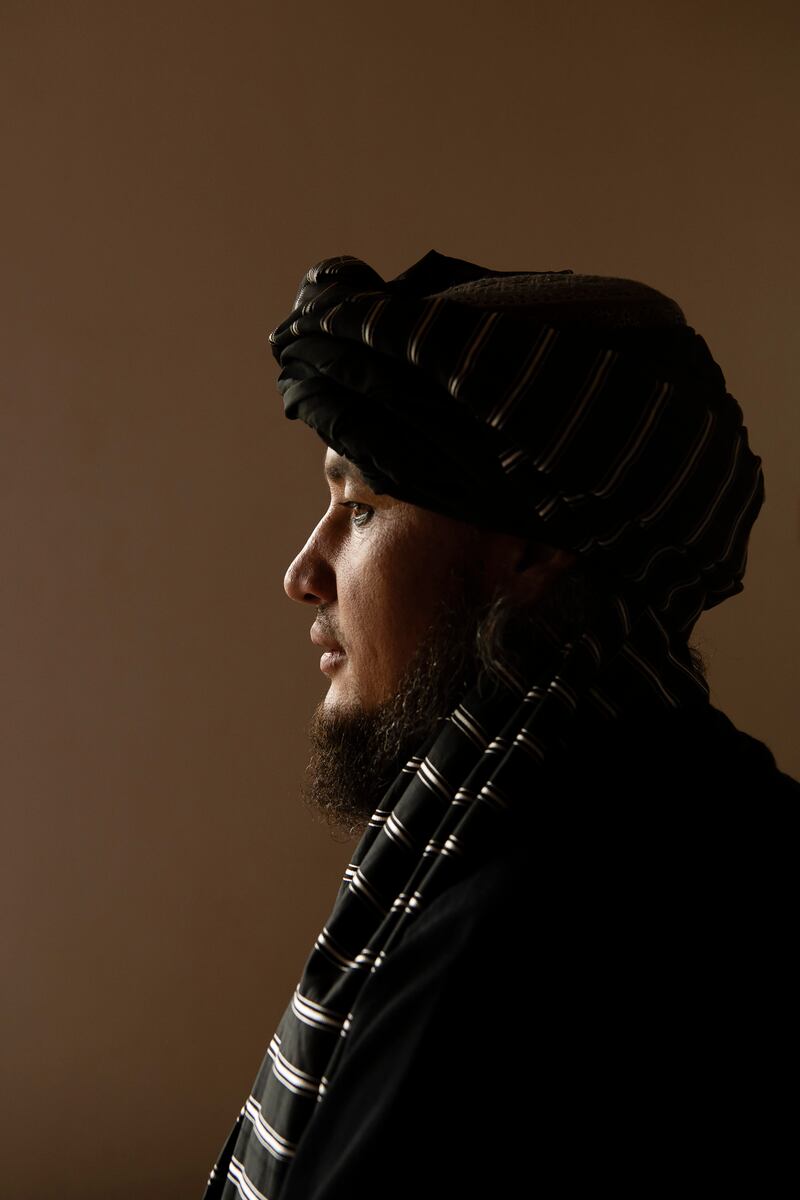The rumbling of engines echoed across the valley at dusk as scores of men with mismatched camouflage and mud-caked Kalashnikovs descended into the town in northern Afghanistan.
Many had driven hours down the snow-capped mountains to reach the town and join forces with Mawlawi Mahdi Mujahid, a former Shia commander within the mostly Sunni Taliban who had recently renounced the new Taliban government and seized control of this district.
For months, the Taliban had tried to bring him back into their fold, wary of his growing clout among some Afghan Shias eager to rebel against a movement that persecuted them for decades. Now Taliban forces were amassing around the district he controlled – and Mahdi and his men were readying to fight.
“If the Taliban do not want an inclusive government, if they do not give rights to Shias and to women, then we will never be able to have peace in Afghanistan,” said one fighter, Sayed Qasim (70). “As long as we have blood in our body, we will fight.”
The clashes in Sar-i-Pul province in June were the latest in a conflict brewing across northern Afghanistan in which a smattering of armed factions have been challenging the heavy hand of the Taliban government – a harsh reminder that Afghanistan has not yet escaped the cycles of violence and bloodshed that defined the country for the past 40 years.
We visited the rebels in Sar-i-Pul in June, getting a rare glimpse into one of these armed groups that, though limited and relatively small, has defied Taliban rule. Interviews with Mahdi, his fighters and villagers paint a portrait of a resistance driven by the grievances of minorities living under an authoritarian government and by the tortured mindset of Afghan men who have known only war and are determined to fight.
Taliban officials have sought to play down any uprising in order to maintain an image of popular support and of providing peace and security to the country. And it is unlikely that any of the eight or so resistance groups that have emerged so far can pose a legitimate threat to the Taliban’s control of the country. The ragtag militias are ill-equipped, underfunded and have been unable to attract backing from any major foreign power.
Still, the Taliban, intent on stamping out any vestige of dissent, have been consistently brutal. The new government has flooded resistance strongholds with thousands of soldiers who have committed summary executions of captured fighters and tortured residents they believe support the armed opposition, according to Human Rights Watch and Amnesty International.
The crackdown is the latest sign that, much like their first regime, the new government relies on force and intimidation to crush any form of dissent. But the brutal tactics risk alienating Afghans already on edge because of the country’s collapsed economy and a return to the Taliban’s hard-line Islamist rule.

The Embers of an Uprising
Early one morning in June, Mahdi gathered a handful of advisers in his home in the centre of Balkh Aab and peered out the dirtied window. Outside, the town seemed to buzz with nervous anticipation. Dozens of armed men milled along the muddied main drag, drinking tea and smoking cigarettes as they waited on their marching orders.
Two weeks earlier, Mahdi had seized control of this untamed slice of northern Afghanistan – prompting Taliban forces to amass along its borders. Now a Taliban offensive seemed imminent, and the brisk mountain air carried a palpable sense of unease. Most of the district’s 40,000 residents were Hazaras, an ethnic minority of predominantly Shia Muslims whom the Taliban consider heretics and massacred by the thousands during their first rule.
The 33-year-old rebel leader had grown up in a village not far from here and joined the Taliban after a stint in prison where he found brotherhood among the Talib prisoners who railed against the corruption of the former government. A rare Hazara member of the southern Pashtun movement, the Taliban showcased Mahdi in propaganda videos as proof of the movement’s inclusivity – a move most saw as little more than a publicity stunt.
But after the Taliban seized power, Mahdi fell out with the new rulers. Most locals say he defected because of a dispute with the Taliban over revenue from Balkh Aab’s lucrative coal mines. By his own telling, Mahdi left the movement in protest, disillusioned with how the insurgents-turned-rulers treated Hazaras.
“After the Islamic Emirate came to power, the Hazaras have suffered the most,” he said in an interview in Balkh Aab. Hazaras “cannot spend their entire lives like this, whether or not they want to now, one day the people will stand against the Islamic Emirate”, he added.
For many residents, Mahdi’s motives did not seem to matter. Hundreds of Shia men eager to take up arms against the Taliban flocked to his new resistance militia in the spring. They were a mix of former policemen, soldiers and veterans of the Fatemiyoun forces, an Iranian-backed militia that fought in Iraq and Syria. To them, his defection offered a rallying cry – proof that no Hazara, even one who had fought on the Taliban’s behalf, would ever be accepted in a country under their control.
“The Taliban must recognise Shia and Hazara and participate in the system,” said Mohammad Jawid (27), who joined Mahdi’s militia this spring. “Otherwise, we are here, and we will fight for our rights.”
Jawid huddled among dozens of Mahdi’s men in a small concrete building perched on the edge of the Qom Kotal mountain at the district’s northern flank. The men had slept in shallow caves, desperate for any protection from the bitter cold winds and wet pounding of snow. Inside the building, dozens of men sat on the floor, their weapons stacked in the corner, and the smell of smoke from a bonfire outside filled the room. Many of the rebels were in their 60s and 70s, with deep creases etched into their brows and ammo belts wrapped around their waist. They had spent their lives fighting first the Soviets and then the Taliban, watching as men like Mahdi switched from enemy to ally, then enemy and ally yet again.
“Do we have rights? Are we not Afghan? For how long can we live like this?” one man shouted from the doorway, as if to rally the cold, shivering militants. “If the fight starts in Balkh Aab, then there will be a fight in Afghanistan!”
Later that night along the district’s southern border, some of Mahdi’s advisers gathered at a rebel safe house on the shores of one of the district’s many rivers. One of the advisers, who, fearing retribution, preferred to go by his surname, Rezayee, arrived on a motorcycle and changed out of his military fatigues into the traditional Afghan salwar kameez.
Sitting on a floor cushion, he smiled and asked us, “So, do you have any advice on how to start a war?”

The Battle for Balkh Aab
For all of his impassioned talk of Shia rights and an enduring stronghold of resistance, Mahdi’s opponent was a weathered insurgent group that would soon apply the full brunt of their decades fighting a global superpower on Mahdi’s ragtag team of men – with gruesome results.
The Taliban launched their offensive in late June, sending thousands of troops through the knee-high snow and jagged peaks to Mahdi’s stronghold on the Qom Kotal mountain. As they opened fire on their positions across the escarpment, helicopters repurposed from the Western-backed government and packed with armed Taliban soldiers orbited overhead. Their tan and green camouflage cut across the pale gray sky as the bone-rattling sound of their rotor blades mixed with the crescendo of automatic fire.
The high-pitched shrieks and heavy thuds of rockets echoed across the mountain and into the valleys below throughout the night, striking terror into the nearby villages. Thousands of residents – once more trapped in a conflict they wanted no part in – loaded the few loaves of bread, water and blankets they had on to the backs of donkeys and began the hours long walk to safety into nearby mountains, where they listened to the depressingly familiar soundtrack of war.
“The people were hungry and thirsty, and the children were crying. We did not know what would happen,” said Reza (27), a resident who fled.
Despite being outgunned and outmanned, the rebels thought their knowledge of their district’s terrain would give them the upper hand. The area is a labyrinth of mountains and canyons that rise out of the earth as if to swallow any invading force. Entering the district centre requires navigating a maze of roads often made impassable by boulders, flash floods and snowstorms that pound the mountains with ice year-round.
But the Taliban found two residents to help them navigate the little-known footpaths into the centre of the district, outflanking Mahdi’s forces as he concentrated his ragtag group of fighters at Qom Kotal, according to rebel fighters, residents and a Taliban official.
As dawn broke the following morning, Mahdi’s men found the farms and riverbeds surrounding the district centre crawling with Taliban soldiers. They opened fire on the unsuspecting rebels who had destroyed the main roads into the town days earlier – a futile attempt to keep the Taliban forces at bay.
For two days, the town was engulfed in running gunbattles between the Taliban and Mahid’s men. Shops that lined its main thoroughfare burned. Mud brick homes and at least one Shia shrine were transformed into defensive positions. As the fighting raged, the Taliban repaired the destroyed roads and sent a convoy of armoured vehicles to hold the territory they seized.
In the twilight hours of the Battle for Balkh Aab, the Taliban turned to one of their tried-and-true weapons – a suicide bomber – to try to flush the last remaining rebel holdouts from the town. The rebels had taken position in one of the homes along the main drag, its metal gate peppered with pockmarks from the fighting. Shell casings littered the surrounding wheat fields, waiting to be discovered by farmers desperate to return to their harvests.
In a lull between bursts of fire, the suicide bomber approached the rebels on foot. But before he could reach their position, Mahdi’s men opened fire, and he detonated. The only casualty was the bomber and a donkey that had wandered into the front line.
Still, the last of Mahdi’s men were surrounded by Taliban soldiers. No rebel reinforcements were on the way. Their only options were to surrender and face what felt like certain death, or retreat. Either way, the uprising was over.

The Aftermath
After the fighting subsided, an eerie quiet fell over the district. Many of the villagers refused to return home from the mountainside, terrified the Taliban would exact revenge on them. The few who did return walked into scenes of carnage.
Dozens of bloodied bodies of Mahdi’s fighters and Taliban soldiers lay strewn across gardens, farmland and dirt roads in the district centre, according to interviews with nearly a dozen locals and a local Taliban official.
A 65-year-old man had been killed after he went to collect the body of his son, a militant with Mahdi who was fatally wounded in the fighting. Both of their bodies were thrown in an open pit in the district centre. Nearby, the blood from the donkey killed by the Taliban suicide bomber splattered the ground.
One resident of Takshar village near the district centre barely looked up as he returned home, he said, terrified of making eye contact with the hundreds of Taliban soldiers standing idly on the road. He asked not to be named, out of fear of Taliban retribution.
As he reached his front gate, the man froze: Lying on the ground were the bodies of three of his male relatives who had stayed behind to guard their home against looters, he said. The man grabbed a shovel and dragged their bullet-ridden and bloodied bodies into shallow graves.
On his way back to the mountains, the Takshar resident stumbled upon four more bodies in a nearby alley, he said. Three looked like Mahdi’s fighters, but he recognised the fourth as an old homeless man, Noor Ahmad, known by the nickname Noorak. He stood there for a moment, torn between the urge to bury them, too, and fear of staying too long around the Taliban.
He decided to drag the bodies under the shade of the tree; at least there, they would not rot as quickly, he thought.
After the fighting ended, Mahdi and dozens of his men escaped into the mountains, eluding the Taliban’s helicopters, Humvees and troops. Twenty-five of his men were killed in the fighting, according to his adviser, Rezayee, while hundreds of others hid their weapons and melted back into their villages.
“The war is not over,” Rezayee said in a phone interview two weeks after the battle. “We promise that this is not the end.”
But the fight did not last long.
Last week, Taliban security forces recognised Mahdi – his face clean-shaven in an attempted disguise – trying to flee across the border into Iran, according to Inayatullah Khwarazmi, the spokesman for the Taliban’s Ministry of Defence, and one of Mahdi’s advisers.
The spokesman said the Taliban killed him. The adviser said the remaining rebels were on the run.
Mahdi’s uprising was over. – This article originally appeared in The New York Times

















